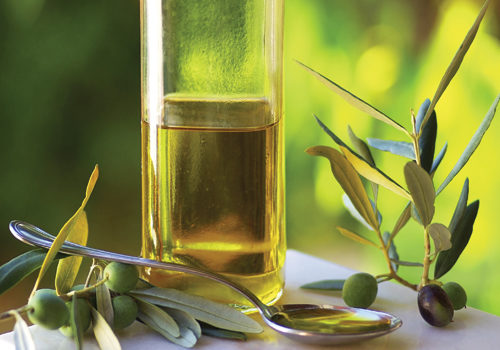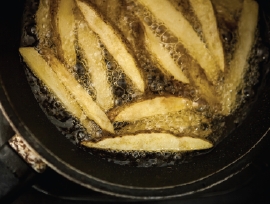Americans have a love–hate relationship with cooking oils. The right culinary oil can transform a so-so recipe into something that tastes amazing. But, a nagging voice in the back of our heads may still warn, “Stop, stop! Oil is bad.” Should we listen?
The Fat Conundrum
Limiting dietary cholesterol and fat (especially saturated fat) has been at the center of the medical community’s advice for avoiding heart disease for decades. But, as Americans were avoiding fats like the plague (often in favor of foods high in carbs, sugar and salt), metabolic syndrome surged and the population hasn’t gotten much healthier.
So, researchers have begun reevaluating whether completely avoiding saturated fat is really the way to go. For one, Aseem Malhotra, M.D., published a piece in 2013 (1) that suggested saturated fat consumption is not a major risk factor for heart disease. In a WholeFoods interview with Richard A. Passwater, he stated, “The dogma of low-fat diet is damaging public health and contributing to the obesity epidemic, and this has to stop.”
One 2015 review of several randomized, controlled trials found that reducing saturated fat may lower 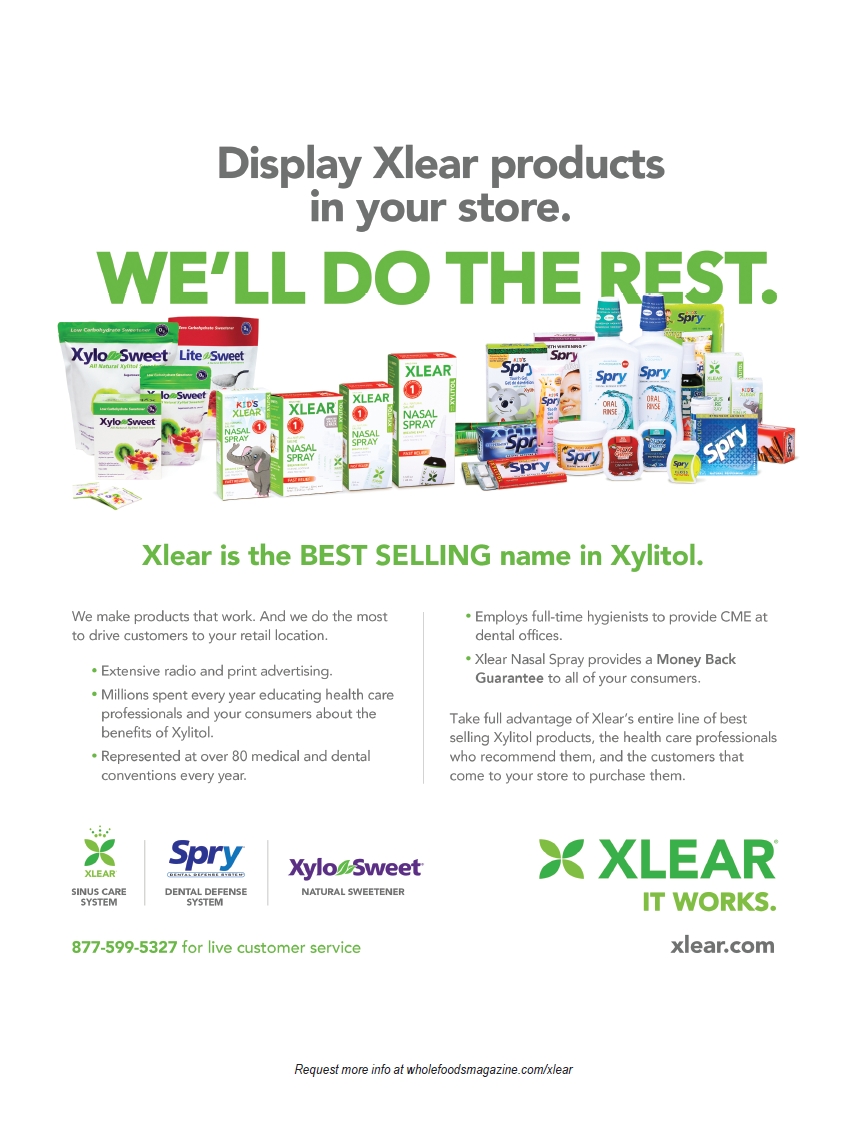 cholesterol, but it does not translate into a reduction in heart disease or mortality (2).
cholesterol, but it does not translate into a reduction in heart disease or mortality (2).
Nonetheless, medical groups like the American Heart Association still suggest that saturated fat should be limited to 7–10% of one’s caloric intake since it can increase the risk of heart disease (3). Some experts recommend replacing saturated fats with monounsaturated fats like canola or almond oil, which support healthy cholesterol oil levels.
“Everything in moderation,” advises Robert Dadd, master herbalist and product information manager at Flora, Inc., Lynden, WA. “Many people’s diets include too much saturated fat along with too little polyunsaturated fats, especially omega-3 ones. “
Dadd says several observational studies recommend replacing some saturated fat intake with polyunsaturated fats to reduce heart disease risk. Says Dadd, “A 2010 meta-analysis (4) of studies found that there was no link between saturated fat and heart disease, but did find some support for replacing saturated fat with polyunsaturated fats.”
Saturated fat also adds extra calories (about 120 calories per serving. Says Matthieu Kohlmeyer, CEO and founder of La Tourangelle, Berkeley, CA, “This also means that one should be picky about what they use and rotate various oils to cover all that the body needs. Essential fatty acids (omegas-3, -6 and -9) are the most important.”
As for definitive answers to the question of whether saturated fat is okay for one’s health, Dadd says, “The truth is likely to be more complex, nuanced and complicated than any easy generalization on this topic and for each individual, there could be a myriad of factors that influence their heart health one way or another.”
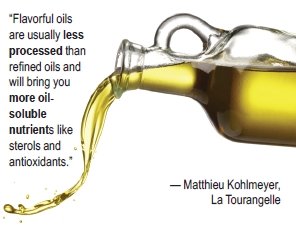 In agreement is Madalyn Crum, marketing team member at Nutiva, Richmond, CA. She states, “It’s important to moderate your fat intake, however, not all saturated fats are created equal.”
In agreement is Madalyn Crum, marketing team member at Nutiva, Richmond, CA. She states, “It’s important to moderate your fat intake, however, not all saturated fats are created equal.”
One reason why is that there are several types of saturated fats, including lauric acid, myristic acid, palmitic acid and stearic acid, and Dadd explains that they have different effects on cholesterol.
The American Heart Association promotes coconut oil as the best of all saturated fats. One reason why is that coconut oil is high in lauric acid (about 50%), which is said to support healthy cholesterol levels, especially by raising good cholesterol levels. Lauric acid is also said to offer antibacterial properties (5). In fact, some studies suggest that coconut oil may fight certain infections, but more research is needed before it can definitively be used for this purpose.
Adds Debbie Shandel, executive vice president and CMO of Carrington Farms, Closter, NJ, “Coconut oil is an excellent choice to use in the kitchen because it is composed of MCTs (medium chain triglycerides), which have been clinically shown to be used for energy and not stored as fat.”
Medium-chain saturated fats like MCTs are processed in the body differently than other longer-chain fats. According to Dave Rosenberg, food category manager for NOW Foods and Ellyndale, Bloomingdale, IL, the longer variety needs more energy to digest and anything that isn’t used for cellular energy is stored as body fat. “By comparison, MCTs are burned as fuel for instant energy needs and very little is ever stored as fat,” he explains.
High-quality saturated fats in moderation may even play a role in supporting good health in several ways including cellular health, bone health, liver health, immune health and more (6), though more research is needed.
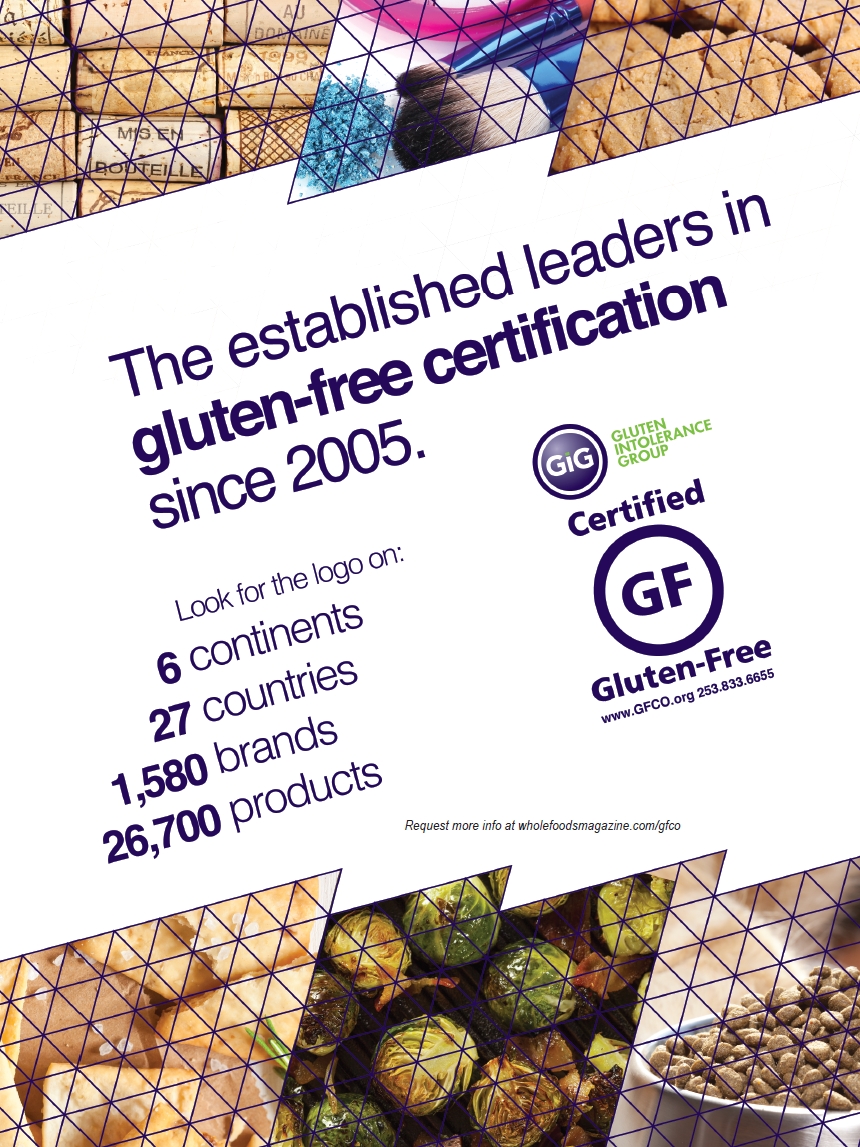 At the end of the day, this complicated discussion underscores the place of the natural products retailer in helping shoppers fully understand all their options for culinary oils.
At the end of the day, this complicated discussion underscores the place of the natural products retailer in helping shoppers fully understand all their options for culinary oils.
So Many Oils, So Little Shelf Space
Coconut oil. Walnut oil. Avocado oil. Olive oil. There are so many interesting options in the culinary oils category that a smaller retailer with limited space for grocery items may wonder which ones are their best bets for marrying practicality and novelty in the kitchen.
“Natural stores need to offer something different than what’s in traditional groceries,” states David Neuman, CEO of Gaea, Hollywood, FL. He says your typical grocery store will offer eight to 10 feet of mostly low-quality, unhealthy, GMO-laden cooking oils and then dedicate a very small portion to natural and clean brands. “I would really go the other way with natural food stores and focus on the brands that offer a point of differentiation,” Neuman states.
Rosenberg says smaller retailers shouldn’t make the common mistake of overloading their stores with olive oils. Olive oil is certainly a critical part of a retailer’s culinary oil options, but oversaturating shelves with this healthy oil often means that “a number of other healthy, gourmet, flavorful oils never make the set,” he states. “There are so many other great options, so we encourage retailers to choose fewer olive oils, leaving room for some lesser-known oils that will quickly become staples in their customers’ kitchens.”
Kohlmeyer breaks the category into three segments: neutral oils, baking oils and beauty oils, suggesting that stores offer some of each. His picks for when one wants an oil with a neutral flavor include organic high oleic sunflower oil, expeller-pressed grapeseed oil or expeller-pressed safflower oil because of its low saturated fat content and high smoke point. His company markets an organic coconut oil/high-oleic sunflower oil blend; he believes blends are “a great way to bring convenience and optimized fatty acid composition together.” And, he says organic canola oil is a great go-to cooking oil.
Regarding olive oil, Neuman says it’s a misconception that extra-virgin olive oil cannot be heated. “The science of it is that the better the quality of olive oil, the more heat it can handle,” he states. That’s because higher quality olive oils tend to have more polyphenols (more on that later) and won’t oxidize as quickly. He says his company offers some olive oils that can be heated to 340+ degrees without degradation. “You can actually fry in it,” says Neuman.
It should be noted that other manufacturers of high-quality extra-virgin olive oils say that they shouldn’t be  used with high heat, and are more intended for drizzling and a quick sauté. So, talk with your manufacturer with questions about specific products.
used with high heat, and are more intended for drizzling and a quick sauté. So, talk with your manufacturer with questions about specific products.
Keep red palm oil in mind for frying, dressings and sautees, too, says Bryan See, regional product manager at ExcelVite Inc., Edison, NJ. “Unlike coconut oil which has about 94% saturated fats, sustainable Malaysian red palm oil has about 50% saturated fatty acids, comprising mainly palmitic acid and stearic acid,” says See. He says that red palm oil can be used as a replacement for trans-fats in products like margarine.
See says red palm oil has “a unique bouquet of phytonutrients/antioxidants,” which include antioxidants like vitamin E tocotrienols, alpha-tocopherol, alpha-carotene, beta-carotene (alpha- and beta-carotenes are provitamin A), gamma-carotene, lycopene as well as a bouquet of other phytonutrients such as phytosterols, plant squalene and co-enzyme Q10. “Other vegetable oils, including coconut oil, do not possess such unique high quantity and quality of health benefiting nutrients,” he believes.
Rosenberg suggests avocado, macadamia nut and sunflower oils for high-heat cooking, flagging avocado as an oil with one of the highest smoke points of all. Meanwhile, sunflower oil has a light taste that pairs well with most foods, he believes, while offering “more vitamin E than other oils” as well as omega-6 and omega-9 fatty acids. And for shoppers that are “looking for a cooking oil that’s big on flavor, macadamia nut oil is a clear winner,” says Rosenberg.
Dadd adds, “For more savory dishes, sesame oil is a classic must-have as well. Ideally, oils would all be certified organic and unrefined/unprocessed.”
As for baking, Kohlmeyer believes that oils should “bring flavor and truly enrich the recipe.” Such oils include walnut oil, avocado oil and organic coconut oil (which can serve as an alternative to butter). Organic canola and sunflower oil also work for baking.
|
Smoking Hot We hear the term “smoke point” a lot in relation to cooking oils, but what does it mean? When oil is heated, its triglyceride molecules—which are bound to glycerol—start to become damaged. When oil gets too hot, it starts smoking and the fat starts breaking off the glycerol. At this point, free radicals are released and glycerol—now free of some fatty acids—breaks down into acrolein. This substance has been linked to cancer and other diseases; some believe this is because acrolein disables the potent antioxidant glutathione (1). For this reason, shoppers should know that oils shouldn’t be heated past their smoke points. If the oil starts to smoke, advise them to clean out the pan and start again. Reference 1. “Oils and Their Effects on Health.” May 16, 2014, http://www.drdobbin.co.uk/oil-and-health, accessed June 20, 2015. |
And for beauty, oils like coconut and avocado can make hair and skin healthy and hydrated. Says Crum of coconut oil, “You can even use it as a moisturizer on your skin, an eye makeup remover or deep conditioning hair treatment.”
When selecting oils, Neuman says organic should be a priority since extraction of refined oils typically requires heat, pressure and chemicals like hexane. “The only way to avoid that is buying organic, since organic oils can’t have any chemicals in the growing or production,” he explains.
Special Delivery
Shoppers may be interested in trying some specialty oils that go beyond the cooking oils they know and love. Rosenberg says sampling is a “must” for educating shoppers about lesser-known oils. He says, “Shoppers will be pleased and surprised at how delicious these alternative oils taste.”
Here are a few to put on their radar.
Avocado oil. Avocado oil imparts a hint of the avocado fruit with grassy/buttery flavors and works great for drizzling over salads or fruit. It is also well suited for cooking. In addition, Kohlmeyer says it has a smoke point of 375 degrees, making it suitable for stir frying, frying, sautéing and baking.
Rosenberg says it has an “incredibly high smoke point, making it one of the most versatile cooking oils available today. This oil also provides health benefits from its healthy monounsaturated fats and vitamin E.” The oil is typically 76% monosaturates (oleic and palmitoleic), 12% polyunsaturates (linoleic and linolenic acids) and 12% saturates (palmitic and stearic acids) (7).
With its oleic acid content, the oil is said to support healthy cholesterol levels. In one small animal study, avocado oil consumption reduced triglycerides, low-density lipoproteins and bad cholesterol as well as some markers of inflammation (8). The oil is also said to be a source of lutein and contain high levels of phytosterols.
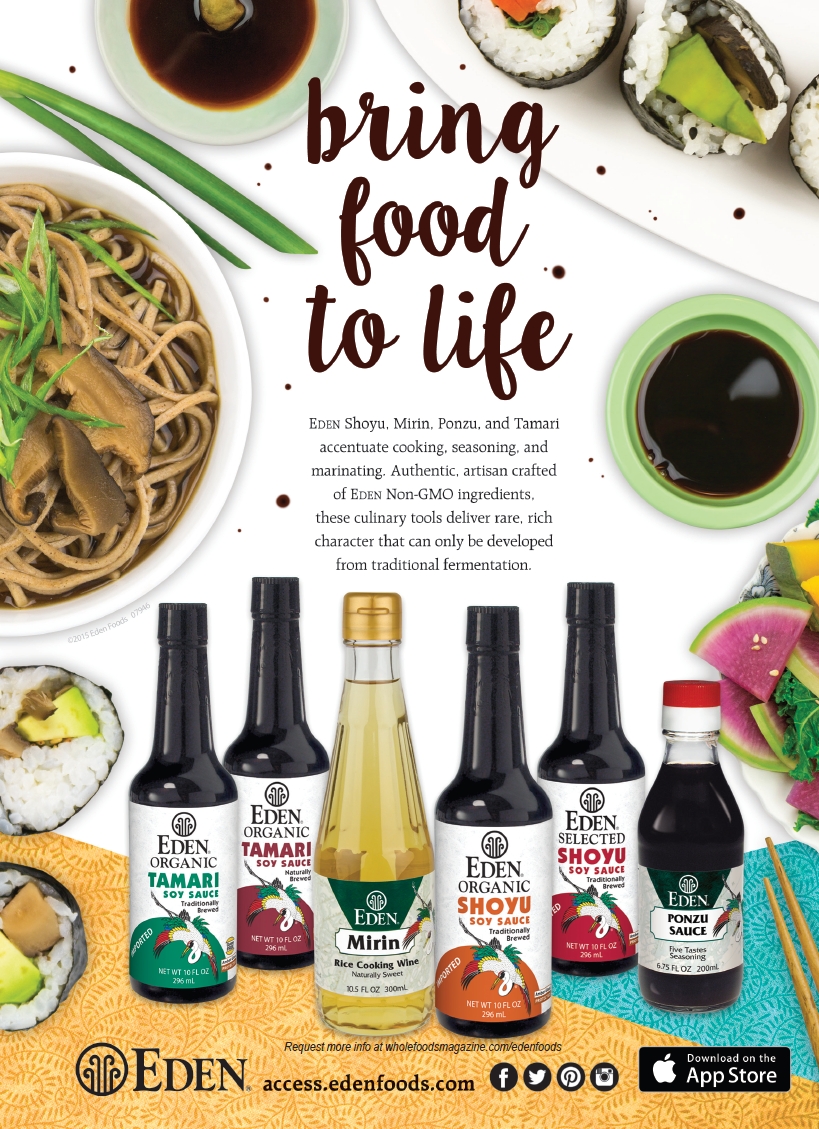 Grapeseed oil. Extracted from the seeds of wine grapes, grapeseed oil is high in polyunsaturated fats and vitamin E. It has a light flavor, and works well in vinaigrettes. This neutral-tasting oil is said to have a high smoke point, and can be used in place of canola oil, making it suitable for deep-frying and sautéing. Says Kohlmeyer, “Grapeseed oil also has one of the richest natural sources of linoleic acid, which has been known to do wonders with fighting heart disease and high cholesterol.”
Grapeseed oil. Extracted from the seeds of wine grapes, grapeseed oil is high in polyunsaturated fats and vitamin E. It has a light flavor, and works well in vinaigrettes. This neutral-tasting oil is said to have a high smoke point, and can be used in place of canola oil, making it suitable for deep-frying and sautéing. Says Kohlmeyer, “Grapeseed oil also has one of the richest natural sources of linoleic acid, which has been known to do wonders with fighting heart disease and high cholesterol.”
In fact, consuming grapeseed oil may help support healthy levels of LDL cholesterol (9).
Macadamia oil. This nut-derived oil is often expeller/cold pressed under high pressure and then bottled. Macadamia oil is usually unrefined, giving it a distinct nutty, buttery flavor and many nutrients. “Macadamia oil with up to 79% monounsaturated fatty acids and very little polyunsaturated fat content is healthful and very stable and absolutely delicious,” stats Rosenberg.
Kohlmeyer adds that macadamia oil is suitable for baking, and has a high smoke point, making it great for stir-frying and searing. “Also try adding macadamia oil to popcorn for a hint of sweetness,” says Kohlmeyer.
Flaxseed oil. Flaxseed oil offers incredible health benefits thanks to its omega-3/-6 content (about 7 grams of ALA per tablespoon [10]), lignans and other components. Researchers believe the oil supports healthy cholesterol levels, cardiovascular health, immune health, healthy inflammation levels and more.
Since this oil cannot be heated, shoppers can enjoy its nutty flavor in dips, over salad, on yogurt and more.
Walnut oil. A source of ALA, this oil is derived from walnuts that have been cold-pressed and filtered to impart a rich walnut taste. Kohlmeyer prefers oil taken from roasted nuts. He states, “If you buy a refined walnut oil, there will be no flavor.”
He recommends the oil for use in salad dressings and vinaigrettes. “It is also delicious on grilled fish or meat,” he suggests.
Coconut oil. Possibly the king of “new” trendy culinary oils, coconut oil has cracked open the category for many shoppers as a healthier alternative to butter and other fats. And, there’s good reason why consumers are nuts over this oil sensation. Says Rosenberg, “Coconut oil has a rich, exotic taste that
|
Recipes with Culinary Oils Feel like trying some coconut blueberry muffins or grilled halibut with avocado oil? Check out our culinary oils recipes at WholeFoodsMagazine.com/grocery/recipes. |
complements almost any dish and brings out hidden flavors. Between the great taste and numerous health benefits of coconut oil, it’s a fantastic cooking oil.”
As previously explained, coconut oil is rich in MCTs, and some research suggests this component may help with healthy weight management. Its lauric acid content may support healthy cholesterol levels; some research suggests it boosts good cholesterol and lowers the bad, though it can’t be said to cure, prevent or treat any disease. Adds Rosenberg, “Coconut also contains the only two essential fatty acids the body cannot produce: linoleic acid and alpha-linoleic acid. The health benefits and sweet exotic taste are why coconut oil is an ideal product for a store’s oil set.”
As for usage, Crum says, “coconut oil can be utilized in a number of different ways and replace dozens of products around your house.”
Shandel suggests offering several types: “An assortment of oils is best but with limited space, other than the basics, it is important to represent both unrefined and refined coconut oil as well as liquid coconut cooking oil,” she states.
Unrefined “pure” or “virgin” coconut oil is taken from fresh coconut meat and then processed, most often using quick drying. Quick drying is exactly like what it sounds; coconut meat is rapidly dried out and then the oil is expressed without bleaching or additives. Since high heat isn’t used, the coconut flavor and aroma is imparted into the oil (11).
While coconut lovers may crave the flavors, others prefer an oil that won’t give their scrambled eggs a coconut flavor. For these shoppers, consider stocking a culinary coconut oil that has been refined and extracted responsibly. Some lower quality versions may use chemical solvents to extract oil from the dried coconut meat. High heat is often used to deodorize the oil, and some even have trans-fats as a result.
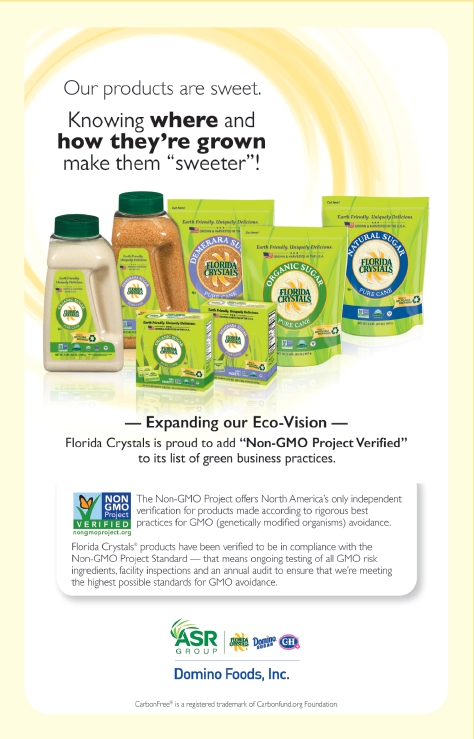 For natural shoppers, look for an organic version that is extracted without chemicals. Nutiva, for instance, uses a chemical-free steam refining process. The end result is a healthy cooking oil with a neutral taste and flavor.
For natural shoppers, look for an organic version that is extracted without chemicals. Nutiva, for instance, uses a chemical-free steam refining process. The end result is a healthy cooking oil with a neutral taste and flavor.
Another option is liquid coconut oils, which are also void of a strong coconut taste and aroma and pour right out of the bottle rather than needing to be scooped like solid coconut oil.
Cooking sprays. Some conventional cooking sprays contain chemicals that many people don’t feel comfortable consuming. A few natural sprays are on the market that don’t have these problems. La Tourangelle, for instance, offers “nut oils in canisters that use compressed air to propel 100% oil, enabling home cooks to cook without the use of harmful products like petroleum, propane and isobutene that often serve as propellants (in products like PAM),” says Kohlmeyer. He feels that shoppers should choose cans with “bag-on-valve technology or non-aerosol spray oils,” which protect oil from oxidation.
Olive oil. Neuman calls olive oil “one of the healthiest oils you can consume” thanks to its polyphenols and monounsaturated fat, which supports cardiovascular health. He calls it the preeminent oil in the kitchen, with one stipulation: it must be made correctly and honorably.
He says, “The better the olive oil, the more polyphenols it has.” He explains this makes the oil greener, spicier and more robust. The earlier an olive is picked, the greener it is in color and the healthier it is.
Rosenberg agrees that stores should zero-in on good-quality oils, saying, “It’s not about the number of olive oils in a store’s set but the quality of those oils.”
Meanwhile, low-quality olive oils are not something you’d want in your store. “The problem with olive oil is that if it is not made and handled with care, the flavor profile of the oil can be altered or even become rancid,” says Rosenberg.
Neuman says some low-quality olive oils are blended from oils from various countries and typically not truly “extra virgin,” despite what the label says.
“There are a few companies who seem to be intentionally mislabeling their oils and are calling them extra-virgin, cold-pressed or pure when the oil is actually a blend or not even mechanically pressed,” adds Rosenberg.
How could this be happening? Kohlmeyer says some unscrupulous brands have been “turning a blind eye on the obvious,” choosing oils that are too cheap to really be extra-virgin olive oil and not investigating the source. He states, “Stores should stay clear of brands that offer value ‘too good to be true’ and from brands that only use descriptions such as ‘packed in...’ Consumers should be weary of products that claim to be ‘packed in Italy’ but not made from Italian olives.”
Another concern, Neuman says, is that some farmers will pick the olives late, so they’re very ripe and full of oil; this method offers a larger yield, but an inferior product that has less polyphenols to protect the oil from smoking. They also cannot take the higher heat that a good-quality olive oil can. “These oils are very low quality and have no life to them,” he states.
Also during processing, Rosenberg says a low-quality oil might use high heat or chemicals to extract the oil, which “can produce more oil but destroys the delicate flavors and aromas.” He adds that if an oil is not extra virgin, there may not be much in the way of the healthy monounsaturated fats.
If you’re wondering whether the oils on your shelves are the best they can be, Dadd suggests “dealing with a reputable supplier that has multiple quality control checks that include identity testing done at various points in the supply chain helps to ensure you are getting the real thing.” WF
References:
1. A. Malhotra, “Saturated Fat Is not the Major Issue,” BMJ 347:f6340 (2013).
2. R. Haney, “Refined vs. Unrefined Coconut Oil,” http://healthyeating.sfgate.com/refined-vs-unrefined-coconut-oil-2296.html, accessed June 18, 2015.
3. http://openheart.bmj.com/content/2/1/e000196.short
4. K.M. Zelman, “The Truth About Coconut Oil,” Mar. 10, 2011, www.webmd.com/diet/coconut-oil-and-health, accessed June 20, 2015.
5. http://ajcn.nutrition.org/content/91/3/535.long
6. “Surprising Health Benefits of Coconut Oil,” www.doctoroz.com/article/surprising-health-benefits-coconut-oil, accessed June 21, 2015.
7. “The Surprising Truth About Saturated Fats,” www.pccnaturalmarkets.com/sc/0602/sc0602-saturatedfats.html, accessed June 21, 2015.
8. http://www.aocs.org/Membership/FreeCover.cfm?ItemNumber=1099
9. Dis Markers. 2014;2014:386425. doi: 10.1155/2014/386425. Epub 2014 Feb 25.
Avocado oil supplementation modifies cardiovascular risk profile markers in a rat model of sucrose-induced metabolic changes.
Carvajal-Zarrabal O1, Nolasco-Hipolito C2, Aguilar-Uscanga MG3, Melo-Santiesteban G4, Hayward-Jones PM1, Barradas-Dermitz DM5.
10. http://www.aocs.org/Membership/FreeCover.cfm?ItemNumber=1099
11. http://www.doctoroz.com/article/6-times-you-shouldnt-use-olive-oil
12. University of Maryland Medical Center, “Flaxseed Oil,” http://umm.edu/health/medical/altmed/supplement/flaxseed-oil, accessed June 21, 2015.
Published in WholeFoods Magazine, August 2015, (online 7/16/2015).

